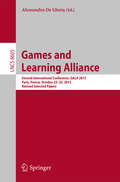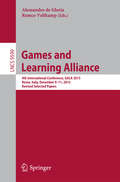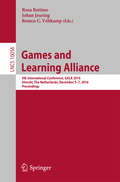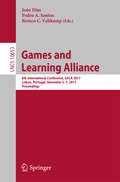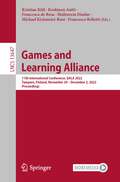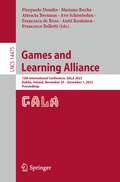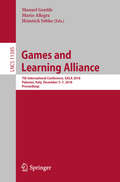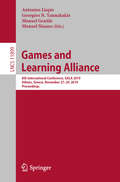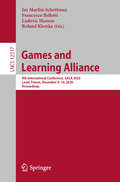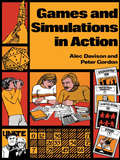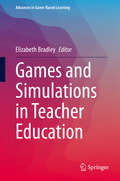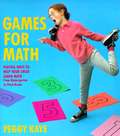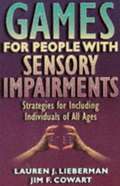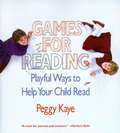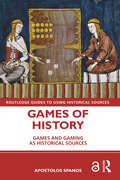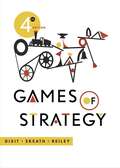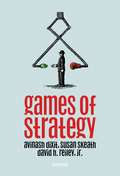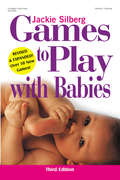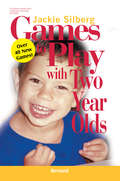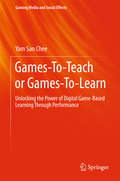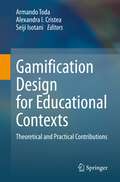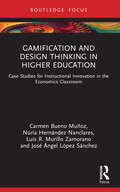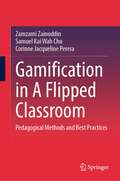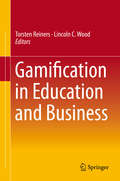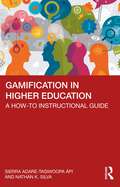- Table View
- List View
Games and Learning Alliance
by Alessandro De GloriaThis book constitutes the refereed proceedings of the Third International Conference on Games and Learning Alliance, GALA 2014, held in Bucharest, Romania, in July 2014. The 15 revised papers presented were carefully reviewed and selected from 26 submissions. The papers presented cover a variety of aspects and knowledge fields. They are grouped into four sessions: pedagogy, technology, design, and applications.
Games and Learning Alliance
by Remco Veltkamp Alessandro De GloriaThis book constitutes the refereed proceedings of the 4th International Conference on Games and Learning Alliance, GALA 2015, held in Rome, Italy, in December 2015. The 33 revised full papers and 15 short papers presented were carefully reviewed and selected from 102 submissions. The papers presented cover a variety of aspects and knowledge fields. They are grouped around the following topics: games for health, games for mobility, pervasive gaming and urban mobility.
Games and Learning Alliance
by Rosa Bottino Johan Jeuring Remco C. VeltkampThis book constitutes the refereed proceedings of the 5th International Conference on Games and Learning Alliance, GALA 2016, held in Utrecht, The Netherlands, in December 2016. The 27 revised regular papers presented together with 14 poster papers were carefully reviewed and selected from 55 submissions. The papers cover topics such as games and sustainability; games for math and programming; games and health; games and soft skills; games and management; games and learning; game development and assessment; and mobile games.
Games and Learning Alliance
by João Dias Remco C. Veltkamp Pedro A. SantosThis book constitutes the refereed proceedings of the 6th International Conference on Games and Learning Alliance, GALA 2017, held in Lisbon, Portugal, in December 2017. The 16 revised regular papers presented together with 6 poster papers were carefully reviewed and selected from 45 submissions. The papers cover topics such as games in education and training; games for health and special children; augmented and virtual reality; methods and tools (for desing and development); and poster abstracts.
Games and Learning Alliance: 11th International Conference, GALA 2022, Tampere, Finland, November 30 – December 2, 2022, Proceedings (Lecture Notes in Computer Science #13647)
by Michael Kickmeier-Rust Francesco Bellotti Francesca De Rosa Kristian Kiili Koskinen Antti Muhterem DindarThis book constitutes the refereed proceedings of the 11th International Conference on Games and Learning Alliance, GALA 2022, held in Tampere, Finland, in November/December 2022. The 27 full papers and 9 short papers were carefully reviewed and selected from 61 submissions. The papers cover a broad spectrum of topics: Serious Games and Game Design; Serious Games for Instruction; Serious Game for Digital Literacy and Numeracy; Novel Approaches and Application Domains; Taxonomies and Evaluation Frameworks.
Games and Learning Alliance: 12th International Conference, GALA 2023, Dublin, Ireland, November 29 – December 1, 2023, Proceedings (Lecture Notes in Computer Science #14475)
by Avo Schönbohm Francesco Bellotti Attracta Brennan Francesca De Rosa Pierpaolo Dondio Mariana Rocha Antti KoskinenThis LNCS volume constitutes the proceedings of 12th International Conference, GALA 2023, in Dublin, Ireland, held during November/December 2023. The 36 full papers and 13 short papers were carefully reviewed and selected from 88 submissions. The papers contained in this book have been organized into six categories, reflecting the variety of theoretical approaches and application domains of research into serious games: 1. The Serious Games and Game Design2. User experience, User Evaluation and User Analysis in Serious Games3. Serious Games for Instruction4. Serious Games for Health, Wellbeing and Social Change5. Evaluating and Assessing Serious Games Elements6. Posters
Games and Learning Alliance: 7th International Conference, GALA 2018, Palermo, Italy, December 5–7, 2018, Proceedings (Lecture Notes in Computer Science #11385)
by Manuel Gentile Mario Allegra Heinrich SöbkeThis book constitutes the refereed proceedings of the 7th International Conference on Games and Learning Alliance, GALA 2018, held in Palermo, Italy, in December 2018.The 38 revised regular papers presented together with 9 poster papers were carefully reviewed and selected from 68 submissions. The papers cover the following topics: games for skills training; game design; methods and tools; gamification and innovative game approaches.
Games and Learning Alliance: 8th International Conference, GALA 2019, Athens, Greece, November 27–29, 2019, Proceedings (Lecture Notes in Computer Science #11899)
by Georgios N. Yannakakis Antonios Liapis Manuel Gentile Manuel NinausThis book constitutes the refereed proceedings of the 8th International Conference on Games and Learning Alliance, GALA 2019, held in Athens, Greece, in November 2019. The 38 regular papers presented together with 19 poster papers were carefully reviewed and selected from 76 submissions. The papers cover the following topics: serious game design and pedagogical foundations; AI and technology for SG; gamification; applications and case studies; and posters.The chapter "Cyber Chronix, Participatory Research Approach to Develop and Evaluate a Storytelling Game on Personal Data Protection Rights and Privacy Risks" is available open access under a CC BY 4.0 license at link.springer.com.
Games and Learning Alliance: 9th International Conference, GALA 2020, Laval, France, December 9–10, 2020, Proceedings (Lecture Notes in Computer Science #12517)
by Iza Marfisi-Schottman Francesco Bellotti Ludovic Hamon Roland KlemkeThis book constitutes the refereed proceedings of the 9th International Conference on Games and Learning Alliance, GALA 2020, held in Laval, France, in December 2020. The 35 full papers and 10 short papers were carefully reviewed and selected from 77 submissions. The papers cover a broad spectrum of topics: Serious Game Design; Serious Game Analytics; Virtual and Mixed Reality Applications; Gamification Theory; Gamification Applications; Serious Games for Instruction; and Serious Game Applications and Studies.
Games and Simulations in Action
by H A Davison A. DavisonFirst published in 1982. Routledge is an imprint of Taylor & Francis, an informa company.
Games and Simulations in Teacher Education (Advances in Game-Based Learning)
by Elizabeth BradleyThis book includes more than twenty computer games and simulations for use in teacher training. Each of these simulations is innovative and presents an opportunity for pre-service teachers to have hands-on experience in an area of need prior to teaching in the classroom. Information on the simulation origins, including theoretical underpinnings, goals, characteristics, relevant research/program evaluation results, discussion of benefits and limitations as well as dissemination, recommended use, scope of practice, etc. of each game or simulation are included. Pre-service and new teachers will gain a number of useful skills through completion of these simulations and higher education faculty and administrators will gain a plethora of research-based and effective training tools for use in their teacher training programs.
Games for Math
by Peggy KayeAt a time when the poor math performance of American school children has labeled us a "nation of underachievers," what can parents--often themselves daunted by the mysteries of mathematics--do to help their children? In Games for Math, Peggy Kaye--teacher extraordinaire and author of the highly praised Games for Reading--gives parents more than fifty marvelous and effective ways to help their children learn math by doing just what kids love best: playing games.From the Trade Paperback edition.
Games for People with Sensory Impairments
by Lauren J. Lieberman Jim F. Cowart"This unique and valuable collection of games and activities, developed by innovative practitioners, fills a long - standing need for a book about teaching student with sensory impairments accompanied by multiple disabilities. I recommend this book highly for use in both inclusive and segregated settings." Diane H. Craft, PhD Professor, Department of Physical Education SUNY Cortland College, NY
Games for Reading: Playful Ways To Help Your Child Read
by Peggy KayeHERE ARE OVER SEVENTY GAMES TO HELP YOUR CHILD LEARN TO READ--AND LOVE IT.Peggy Kaye's Games for Reading helps children read by doing just what kids like best: playing games. There is a "bingo" game that helps children learn vocabulary. There is a rhyming game that helps them hear letter sounds more accurately. There are mazes and puzzles, games that train the eye to see patterns of letters, games that train the ear so a child can sound out words, games that awaken a child's imagination and creativity, and games that provide the right spark to fire a child's enthusiasm for reading. There are games in which your child has to act silly and games--sure to be any child's favorite--in which you do.Easy to follow and easy to play, these games are ideal for busy, working parents. You can read a game in a few minutes and start to play right away. You can play on car trips, while doing the laundry, or while cooking. These games are so much fun for the whole family that you may forget their serious purpose. But they will help all beginning readers--those who have reading problems and those who do not--learn to read and want to read.Games for Reading also includes a list of easy-to-read books and books for reading aloud, and a "Note to Teachers" on how to play these games in their classrooms.From the Trade Paperback edition.
Games of History: Games and Gaming as Historical Sources (Routledge Guides to Using Historical Sources)
by Apostolos SpanosGames of History provides an understanding of how games as artefacts, textual and visual sources on games and gaming as a pastime or a “serious” activity can be used as sources for the study of history. From the vast world of games, the book’s focus is on board and card games, with reference to physical games, sports and digital games as well. Considering culture, society, politics and metaphysics, the author uses examples from various places around the world and from ancient times to the present to demonstrate how games and gaming can offer the historian an alternative, often very valuable and sometimes unique path to the past. The book offers a thorough discussion of conceptual and material approaches to games as sources, while also providing the reader with a theoretical starting point for further study within specific thematic chapters. The book concludes with three case studies of different types of games and how they can be considered as historical sources: the gladiatorial games, chess and the digital game Civilization. Offering an alternative approach to the study of history through its focus on games and gaming as historical sources, this is the ideal volume for students considering different types of sources and how they can be used for historical study, as well as students who study games as primary or secondary sources in their history projects.
Games of Strategy
by Avinash K. Dixit Susan Skeath David H. ReileyGames of Strategy, famous for its simple yet accurate exposition and its great examples and exercises, has been extensively revised for this Fourth Edition. The key to its broad success is that the authors assume no prior knowledge of game theory and present the material in the most accessible way possible. With new and improved features and compelling end-of-chapter exercises, this Fourth Edition of Games of Strategy continues to engage students around the world.
Games of Strategy (3rd Edition)
by Susan Skeath David Reiley Avinash DixitThe third edition uses resonant, real-world examples to simplify complex theoretical ideas, helping students see the value of strategic thinking in a variety of situations.
Games to Play with Babies
by Jackie SilbergOver 240 fun-filled games include lots of hugs and kisses to help babies bond with their caregivers and parents as they develop necessary skills. Babies experience the interaction and nurturing they need for healthy self-esteem. This book encourages the development of happy, trusting babies who will become happy, trusting toddlers. If there's a baby in your child care center or in your family, you won't want to miss these wonderful games.
Games to Play with Two Year Olds REVISED EDITION
by Jackie SilbergThis revised and updated edition, featuring all-new illustrations and 40 new games, is packed with opportunities to build confidence and to enhance language, coordination, social interactions, and problem-solving skills. Games to Play with Two Year Olds is a must-have for anyone caring for a child between the ages of two and three. Turn ordinary, everyday routines into fun learning experiences!
Games-To-Teach or Games-To-Learn
by Yam San CheeThe book presents a critical evaluation of current approaches related to the use of digital games in education. The author identifies two competing paradigms: that of games-to-teach and games-to-learn. Arguing in favor of the latter, the author advances the case for approaching game-based learning through the theoretical lens of performance, rooted in play and dialog, to unlock the power of digital games for 21st century learning. Drawing upon the author's research, three concrete exemplars of game-based learning curricula are described and discussed. The challenge of advancing game-based learning in education is addressed in the context of school reform. Finally, future prospects of and educational opportunities for game-based learning are articulated. Readers of the book will find the explication of performance theory applied to game-based learning especially interesting. This work constitutes the author's original theorization. Readers will derive four main benefits: (1) an explication of the difference between game-based-teaching and game-based learning, and why this difference is of critical importance, (2) an exposition of the theory of game-based learning as performance, (3) concrete exemplars and research outcomes relating to three game-based learning curricula that have been empirically evaluated in schools, and (4) an understanding of complex issues related to the human side of school change that must be effectively addressed to achieve take-up of game-based learning in schools.
Gamification Design for Educational Contexts: Theoretical and Practical Contributions
by Alexandra I. Cristea Seiji Isotani Armando TodaHave you ever wondered how to best add game-like elements to your (online) courses? What makes some game features desirable, and others boring? This book covers gamification design in educational domains. It is aimed at practitioners, researchers and academics alike. Gamification design is a recent and relevant topic in many domains; however, it is not well explored in the domain of education, with only a few frameworks available and most of these being only academic (e.g., theoretical) and not addressing practical issues related to education practitioners (e.g., teachers and instructors). The book is divided into 3 parts, in part 1 we explain some basic concepts related to gamification and gamification design, its importance for the education domain, possible negative effects if gamification design is neglected, and aspects that are still not encompassed by this field. Following, part 2 focus on explaining data-driven gamification design concepts as well as a research framework on how to use data mining algorithms to analyze and interpret data to generate strategies that can be used in education domain. It also presents a conceptual framework on how to apply those strategies in the education domain, focusing on the teacher and instructor; Finally, part 3 presents discussions regarding the concepts covered in the book, as well as possible research directions
Gamification and Design Thinking in Higher Education: Case Studies for Instructional Innovation in the Economics Classroom (Routledge Research in Higher Education)
by Carmen Bueno Muñoz José Ángel López Sánchez Núria Hernández Nanclares Luis R. Murillo ZamoranoThis book analyzes the use of gamification and design thinking in higher education, examining how both techniques can be combined and used together to promote motivation, engagement, and participation among students. Using two in-depth examples, the authors show that the introduction of a gamified design in a design thinking activity can be a powerful tool to enhance the experiences of students in the teaching-learning process of a subject; motivate participants in a design thinking activity in the university environment; and enhance skills such as creativity, critical thinking and problem-solving, and collaboration, widely demanded in the labor market. Further, they examine how gamification and design thinking in the educational field can enable both the motivation and engagement of students and promote behavioral changes that materialize as a boost in learning outcomes and academic performance. Providing valuable recommendations and insights into the analysis, design and development, and implementation and evaluation of gamified design thinking activities to be carried out in higher education, as well as examining relevant ethical issues, the book will appeal to scholars, researchers, academic faculty, and educators working in the field of higher education, and with interests in educational psychology and theories of learning.
Gamification in A Flipped Classroom: Pedagogical Methods and Best Practices
by Samuel Kai Chu Zamzami Zainuddin Corinne Jacqueline PereraThis book introduces to researchers and teaching practitioners the concept of gamification within a flipped classroom setting, which resonates with the best practices of flipped learning, gamified learning, and gamified flipped learning. The gamified flipped learning (flipped learning plus gamification) approach combines two emerging pedagogies into a single pedagogical form of instruction and serves as an alternative resolution to counter the challenges that arise from flipped learning and gamified learning as separate pedagogies. This book also examines assessment systems for flipped classrooms, showcases various examples of gamification in flipped classroom designs, and reviews educational applications containing game elements for a flipped classroom setting.
Gamification in Education and Business
by Torsten Reiners Lincoln C. WoodThis book is dedicated to applied gamification in the areas of education and business, while also covering pitfalls to avoid and guidelines needed to successfully implement for a project. Using different theoretical backgrounds from various areas including behavioral economics, game theory, and complex adaptive systems, the contributors aim to help readers avoid common problems and difficulties that they could face with poor implementation. The book's contributors are scholars and academics from the many areas where the key theory of gamification typically comes from. Ultimately, the book's goal is to help bring together the theories from these different disciplines to the field of practice in education and business. The book is divided into four parts: Theory, Education, Business, and Use Cases. Part I provides a foundation on the theory of gamification and offers insight into some of the outstanding questions that have yet to be addressed. In Part II, the application and value that gamification can bring within the education sector is examined. The book then changes focus in Part III to spotlight the use of gamification within business environments. The topics also cover educational aspects like improved learning outcomes, motivation, and learning retention at the workplace. Finally Part IV concentrates on the applications and use of gamification through a series of case studies and key elements that are used in real situations to drive real results.
Gamification in Higher Education: A How-To Instructional Guide
by Sierra Adare-Tasiwoopa ápi Nathan K. SilvaGamification in Higher Education is a user-friendly text for anyone curious about gamification and how it increases student engagement. This book presents actual examples from gamified college courses, furnishing strategies and detailed plans for integrating gamification, regardless of the subject area, discipline, or modality. Moreover, the step-by-step how-to aspects of gamification that do not require expensive, proprietary gaming software set this book apart from others in the field. Gamification in Higher Education explores ways to incorporate real-world simulations and promote critical thinking skill, while focusing on storytelling through which to draw in students and help them get into the game, both literally and figuratively. Additionally, the book examines gamification research and how it can be used to support reluctant learners who normally struggle with complex course content. The authors share their experiences with what has worked and, more importantly, what has not worked in adding gamification to their courses. This key resource offers educators a practical guide that will take instructors step-by-step through the design, development, and implementation of game elements, games, and fully gamified courses without using costly specialized software. Its conversational tone endeavors to put educators, whether novice, mid-career, or veteran, at ease with the process of gamification.
